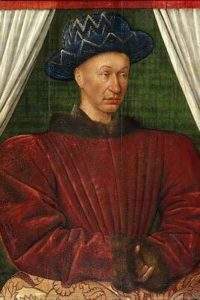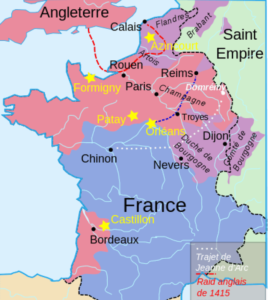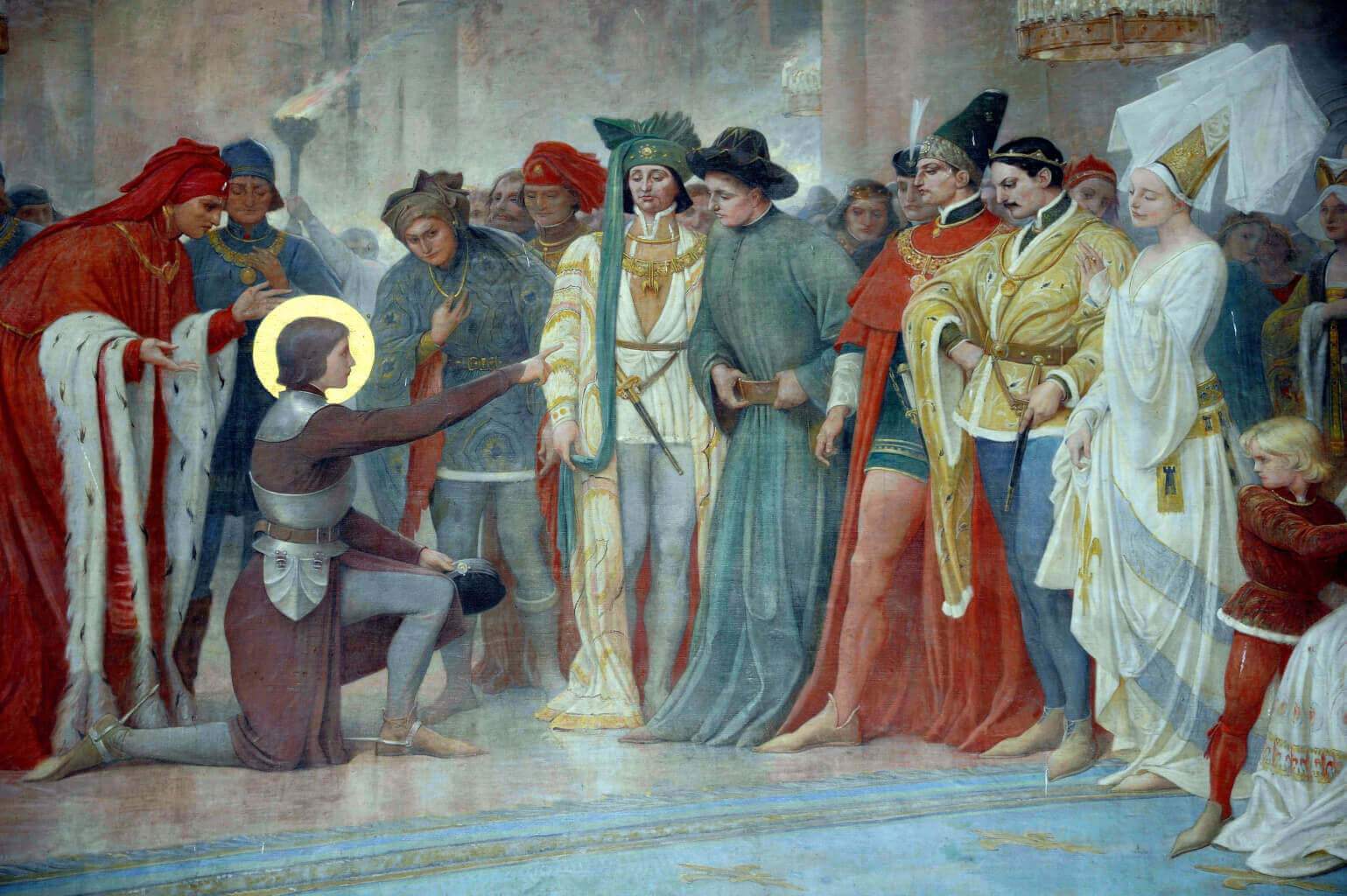To understand the Johannine epic, we must go back to the context of the Hundred Years’ War and find out why Joan wanted, one fine day in 1428, to go and meet the king.
The deep roots of the conflict date back to 1066 when William of Conqueror, Duke of Normandy, invaded England. Although he was King of England, he remained the vassal of the King of France, to whom he had to pay tribute, for his French possessions: Normandy, Maine, Anjou, Aquitaine.
A few centuries later, in February 1328, after the extinction of the direct Capetian dynasty (that of the cursed kings), the crown of France was vacant. The Greats of France chose Philip VI of Valois rather than Edward III of England. This was a breach of feudal law since Edward was the grandson of the King of France by his mother, Isabella, while Philip was only his nephew. The Greats of France justified their choice by an old text of the Salic law according to which a woman could not inherit the throne. And therefore cannot pass on a right she does not have.
In 1337, Edward III, King of England, nevertheless took the title of King of France and challenged his cousin Philip “who called himself King of France”.
Thus began the Hundred Years’ War, which was nothing more than a family quarrel, first between Plantagenets and Capetians, then between Lancaster and Valois. It will in fact last 116 years, with periods of war and periods of truce.
Three major events
Three major, interrelated events are going to change the game.
1- On November 23rd 1407, Duke Louis d’Orléans, the king’s brother, was assassinated on rue Vieille du Temple in Paris. He had just come out of a “merry supper” at the home of the queen, Isabeau of Bavaria, his mistress. The patron is his cousin, the powerful Duke of Burgundy, John the Fearless, who does not admit to having been excluded from the Royal Council and the advantages that go with it. The victim’s son, Charles d’Orléans, will join forces with his father-in-law, Bernard VII of Armagnac to fight Burgundy. Thus was born the civil war between Armagnacs and Burgundians. This fratricidal war will only end in 1435 with the Treaty of Arras.
2- On the 10th September 1419, Duke Jean sans Peur was assassinated in his turn, on the bridge of Montereau, by Tanneguy du Chastel under the eyes of the dolphin Charles (future Charles VII).
3- The victim’s son, Duke Philippe of Burgundy, known as Philippe the Good, was mad with rage. His revenge will be terrible: he decides to join forces with the English to deliver the crown of France to them. Too weakened by this alliance between Burgundians and English, the King of France has no choice. Thus, was signed on May 21, 1420 the famous Treaty of Troyes, which historians call “the infamous Treaty of Troyes”.

The mad king, Charles VI and his wife, Queen Isabeau of Bavaria, therefore signed a treaty in Troyes with their worst enemy, King Henry V of England. The two monarchs decide to put an end, once and for all, to this never-ending war and to settle once and for all the problem of succession to the throne of France.
The Treaty of Troyes is not, however, infamous in my eyes. It is a peace treaty and an act of succession. In particular, it provides that:
1-Charles de Valois, called “the so-called dolphin” in the text, is removed from the throne. It is mainly blamed for being behind the assassination of John the Fearless, the Duke of Burgundy on September 10, 1419.
2- The daughter of the King and Queen of France, Catherine of Valois, is given in marriage to the King of England, Henry V.
3- The future male child of the Franco-English couple will be both King of France and England upon the death of the two monarchs.
On paper everything is therefore settled. Charles VI and Henry V died two years later, a few months apart. Henri died on August 31, 1422 and Charles on October 31, 1422.
The Treaty of Troyes becomes applicable. And it is applied.
Jeanne enters the stage!

But the dolphin Charles doesn’t hear it that way. With the help of those who remained faithful to the Valois, he wants to preserve the kingdom of France. In 1418, he fled the capital occupied by the Anglo-Burgundians and settled in Bourges. Hence his nickname “little king of Bourges”. Married to Marie d’Anjou, daughter of Yolande d’Aragon, he was crowned in 1422 in Poitiers, the new capital of the kingdom of France. He was crowned but he was not anointed.
However, on December 6, 1421 was born in London the young Henry who, nine months later, would become King of England and King of France according to the Treaty of Troyes.
The situation is unprecedented in Christianity. Here are two kings, both of divine right, who are competing for the same crown. Who can settle this dispute? Who can speak the law? There is only God! God and only God.
But how does he speak? From time immemorial God has made his will known to mankind through the voice of the prophets. At least since Moses.
This is where Joan comes in. It’s a great idea. Jeanne will be a prophetess. She will carry the word of God. She will tell who is the true king and who is the usurper.
On Domremy’s side, in the Duchy of Bar, a girl hears voices. Saint Michael, the leader of the heavenly militia, Saint Catherine of Alexandria and Saint Margaret of Antioch command her to take up arms against the English. God has therefore chosen the legitimate king: it will be Charles of Valois. And King Henry VI the usurper.
In February-March 1428, Joan left Domrémy and the d’Arc family, she went to Vaucouleurs and after a few quarrels with the captain of the stronghold, Robert de Baudricourt, she went to meet King Charles in Chinon. She told him that she had been given the mission to liberate the city of Orléans, besieged by the English since October 1428, and to lead him to his worthy coronation in Rheims.
She did not doubt the success of her enterprise since God was with her.
(To be continued: Who conceived Operation Pucelle?)
A few points of reference
*The kingdom of France

At the time of the Treaty of Troyes, in 1420, the kingdom of France was very limited. The possessions of the King of France were mainly concentrated below the Loire River, including the Languedoc States. But the kingdom does not possess Guyenne (Bordeaux), Normandy or the Duchy of Burgundy.
The king of France, is called Charles VI. He has been mad for a long time. When he is in crisis, he can’t stand his wife, the Queen of France Isabeau of Bavaria. “What is this woman whose sight obsesses me,” he says, throwing dishes in her face?
Fearing that he would harm the queen, Isabeau was lodged in the Hotel Barbette where she led a dissolute life while the king stayed at the Hotel Saint-Pol.
* The Church
-University.
It is composed of fanatical theologians, the powerful university of Paris is fiercely opposed to the King of France, to whom it disputes absolute power in order to better establish its own. Closely linked to the Inquisition, the university is empowered to recognize heresies and even to excommunicate in the name of the Church.
In 1429, the university made no secret of its preference for the King of England, who granted his subjects, as early as three centuries ago, the Magna Carta, the Magna Carta, the Great Charter of Liberties which guarantees the right to individual liberty and limits royal arbitrariness. When Jeanne was taken in front of Compiègne, the university repeatedly asked the Duke of Burgundy to deliver her to him to be tried in Paris. But the Duke of Burgundy did not comply.
-The religious orders.
Fervent supporters of the cult of the Virgin, unlike the Dominicans, the Franciscans live close to the people and often, like them, in poverty. They are in favour of Armagnacs. Franciscan networks played an occult and yet decisive role throughout Jeanne’s public life.
The Dominicans, with more dissolute mores, are openly pro-Burgundian.
-Bishop Cauchon.
Pierre Cauchon de Sommièvre (1371-1442), born in Rheims, a Parisian university graduate in canon law, doctor of theology, appointed rector of the University of Paris in 1403, he became one of the advisers of John the Fearless in 1409. Bishop of Beauvais from 1420 to 1432 (then of Lisieux from 1432 to 1442), he took refuge in Rouen because of the advance of Charles VII’s troops into his diocese of Beauvais. Jeanne having been taken in this diocese and transferred to Rouen, it is thus Cauchon who is very normally in charge of presiding over the tribunal which will judge and condemn her. In 1435, he took part in the Council of Basel. He died in Rouen in 1442. In our opinion, Cauchon played a double game in Jeanne’s trial in Rouen. He knew exactly who he was dealing with.
-Regnault of Chartres.
The archbishop of Rheims, Regnault of Chartres, presided over the commission of Poitiers to examine Jeanne at the request of the king. He doesn’t like the one who pretends
*The Duchy of Burgundy
Jean without fear Duke of Burgundy was murdered on the bridge of Montereau-Fault-Yonne. His son, Philip “the Good” Duke of Burgundy (1396-1467), is the brother-in-law of the Regent Bedford, and has been associated with the English since 1420.
Count of Flanders, d’Artois he married: 1° Michèle of France († 1422), daughter of Charles VI and Isabeau of Bavaria; 2° Bonne d’Artois († 1425), daughter of Philippe d’Artois and Marie de Berry; 3° Isabelle of Portugal († 1472). He founded the Order of the Golden Fleece in 1430 on the occasion of his marriage to Isabella of Portugal in Bruges.
John II of LUXEMBOURG (1385-1440).
Count of Guise and Ligny, Lord of Beaurevoir, he was the son of John of Luxembourg and Marguerite d’Enghien, Countess of Brienne. In the service of the Duke of Burgundy, he was in charge of the siege of Compiègne in 1430 and refused to sign the Treaty of Arras which in 1435 consecrated the reconciliation between France and Burgundy. Charles VII was about to mount an operation against him when he died in 1441. He had married in 1418 Jeanne de Béthune, daughter of Robert de Béthune, viscount of Meaux.
Jean de Luxembourg bears the scars of a long military career. He is one-eyed. He was wounded in the face by a spear at the siege of Allibaudières, in Champagne, in 1420, and had part of his nose amputated after being struck with a violent sword the following year at the battle of Mons-en-Vimeu.
On that day, just before the fighting, the Count of Ligny knighted the young Duke Philippe of Burgundy. The two men would remain bound by a sincere friendship. So much so that Jean de Luxembourg became a member of the Golden Fleece on the very day it was created.
*The kingdom of England
–Henri V, King of England (20 March 1413-31 August 1422) is the winner of Azincourt. This battle, fought on 25 October 1415, was a terrible defeat for French chivalry. 6,000 dead, 2,200 prisoners on the French side, including Charles d’Orléans, the prince-poet. On the English side, barely 600 dead and only 13 knights prisoners.
–John of Lancaster Duke of Bedford (1389-1435) is the younger brother of the late King of England Henry V, appointed in 1422 regent of the kingdom of France on behalf of the little king Henry VI (born in 1421). Wife 1° Anne of Burgundy, daughter of John the Fearless, 2° Jacquette, daughter of the Count of Saint-Pol. After the victories of Verneuil and Cravant, he ordered the campaign on the Loire and the siege of Orleans in the autumn of 1428, an expedition entrusted to Salisbury who was killed at the start of the siege.
*The great captains.
John TALBOT (1373-1453), Earl of Shrewsbury. Commander-in-Chief of the English army at the siege of Orleans after the death of Salisbury, he lifted the siege on 8 May 1429. Taken prisoner at Patay on 18 June 1429. Lieutenant-General of Henri VI in Guyenne, he was killed at the Battle of Castillon on 17 July 1453, which marked the end of the Hundred Years’ War.
William de La Poole (called “Guillaume La Poule” by Jeanne la Pucelle) Earl of Suffolk (1396-1450), he commanded the Place de Jargeau which was invested in the autumn of 1428. He capitulated on June 12, 1429 and was taken prisoner. His brother John was also captured and his brother Alexander was killed.
John FASTOLF (1378-1459), from a noble family in Norfolk, served in Ireland under Thomas of Lancaster and then in Gascony. Captain de Harfleur in 1415, he fought at Azincourt. Henri V made him governor of the Bastille Saint-Antoine in Paris. He suffered the defeat of Patay and acquired – wrongly – a reputation as a coward, which is at the origin of Shakespeare’s character of Falstaff.
Richard Beauchamp, Earl of Warwick is Talbot’s father-in-law. He is governor of the castle of Bouvreuil in Rouen. Warwick is considered the most valiant knight of his time.

